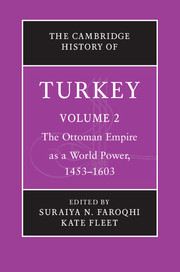Book contents
- Frontmatter
- Contents
- List of Illustrations
- List of Maps
- List of Contributors
- Chronology
- A note on transliteration
- Maps
- 1 Introduction
- Part I An Expanding Empire
- 2 The Ottomans, 1451–1603
- 3 Ottoman expansion in Europe, ca. 1453–1606
- 4 Ottoman expansion in the East
- 5 Ottoman expansion in the Mediterranean
- 6 Ottoman expansion in the Red Sea
- Part II Government, Economic Life and Society
- Part III Culture and the Arts
- Glossary
- Bibliography
- Index
- References
6 - Ottoman expansion in the Red Sea
from Part I - An Expanding Empire
Published online by Cambridge University Press: 05 July 2013
- Frontmatter
- Contents
- List of Illustrations
- List of Maps
- List of Contributors
- Chronology
- A note on transliteration
- Maps
- 1 Introduction
- Part I An Expanding Empire
- 2 The Ottomans, 1451–1603
- 3 Ottoman expansion in Europe, ca. 1453–1606
- 4 Ottoman expansion in the East
- 5 Ottoman expansion in the Mediterranean
- 6 Ottoman expansion in the Red Sea
- Part II Government, Economic Life and Society
- Part III Culture and the Arts
- Glossary
- Bibliography
- Index
- References
Summary
The defeat of the Mamluk army by Ottoman forces in 1516 and 1517, a defeat due in particular to the Ottoman use of firearms, resulted, on the one hand, in the establishment of Ottoman suzerainty over the region of Syria and Egypt and, on the other, presented the Ottomans with the opportunity of wielding influence over the Red Sea. Gaining possession of the economic resources of Egypt, and having before them the prospect of southward expansion and dominance of the Red Sea, Arabian coastlines, Yemen and the shores of north-east Africa, the Ottomans also gained a religious significance with the occupation of the şeriflik (a position belonging to the descendants of the prophet Muhammad) of Mecca, which thus made the sultan the “protector of Mecca and Medina”. The Ottomans’ success, both in gaining effective control in a region which formed one of the important pilgrimage routes and in securing dominance of the Red Sea route, one of the trade routes linking the eastern Mediterranean with the Indian world on which were situated key cities such as Aden, Mocha, Jeddah, Yanbu, Hodaida, Massawa and Suez, meant that they were now in a position to present themselves as a strong Islamic and imperial force against the sea empire of the Portuguese, which was attempting to prevent Ottoman encroachment in the region.
The reasons for the Ottomans turning their attention to the Mamluks, whom they had initially failed to defeat in the reign of Bayezid II (r. 1481–1512), cannot be sufficiently explained by linking the attack to the hostility of the Mamluks as allies of the Safavids, whom Selim I (r. 1512–20) had successfully attacked in order to eliminate the Shi’i danger.
- Type
- Chapter
- Information
- The Cambridge History of Turkey , pp. 173 - 202Publisher: Cambridge University PressPrint publication year: 2012



